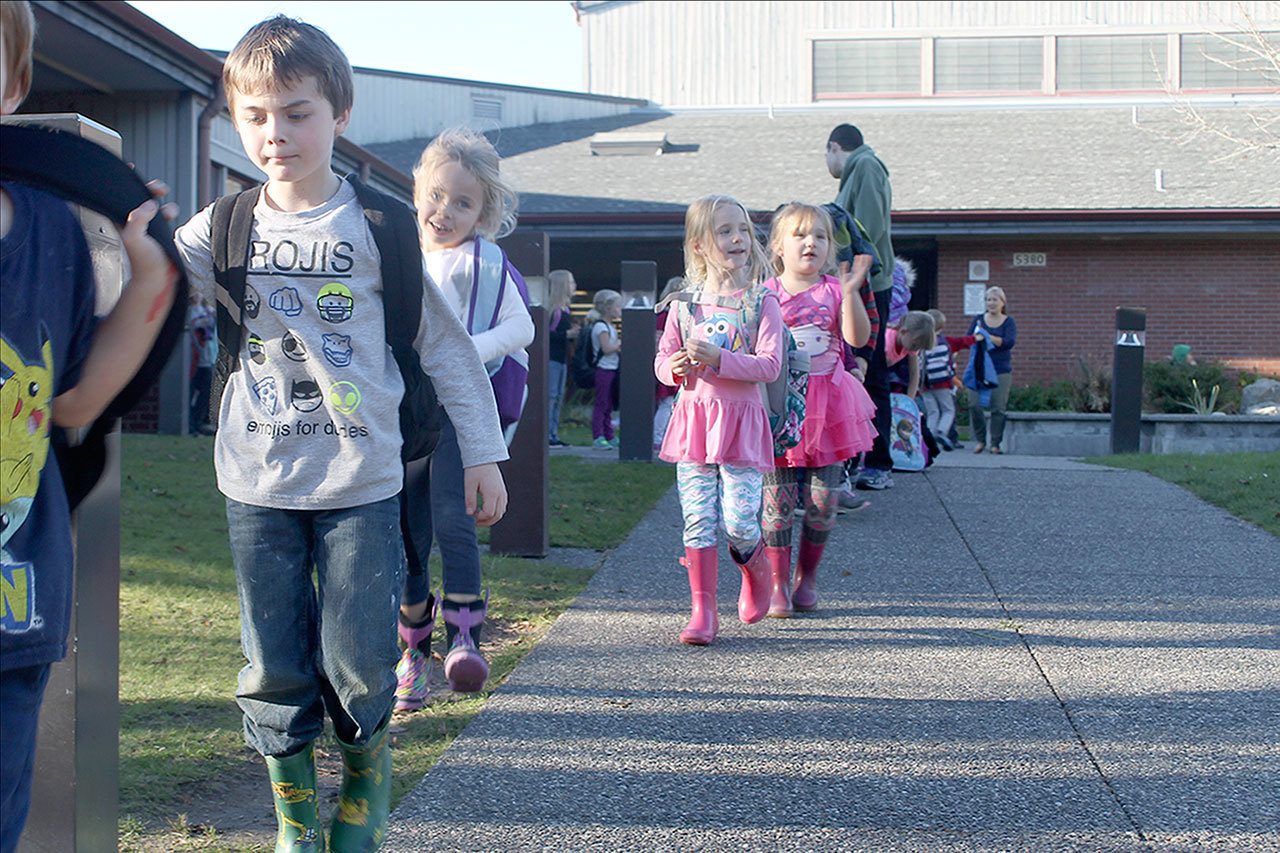A picture that was once a blur of how the South Whidbey School District might consolidate its facility usage became more clear at a recent community meeting, and it may include one less school.
District officials presented three potential money-saving scenarios to an audience of around 40 people Wednesday night in the South Whidbey High School commons. Two of the scenarios would effectively close at least one school to students — either Langley Middle School or the primary school — while all three include the shuffling of students from one or two school campuses to another.
The district needs to reduce around a half million dollars in expenditures by September 2017 in order to fulfill a school board policy that requires it to end with a positive fund balance of 6 percent of its approximately $16 million budget — around $998,000. Consolidating the district into two school buildings would go the furthest in helping the district meet its state requirement, administrators said. If the district does nothing, its fund balance would be $432,479 for the 2017-18 school year. A lack of money for staff, whose salaries and benefits make up 85 percent of the district’s budget, would come as a result.
This cannot happen, school leaders say.
“It will come one way or the other,” Superintendent Jo Moccia said. “…We will be implementing something by September. That’s not a question.”
One last community meeting will be held in the commons on Dec. 4. Following a workshop discussion scheduled for 6:30 p.m. on Jan. 11, 2017, the South Whidbey School Board will make an official decision at a meeting on Jan. 25.
The plans, which also contain tentative map layouts for the school campuses, are available on the district’s website.
The first scenario would close the middle school, move sixth graders to the elementary school and shift grades 7 and 8 to South Whidbey High School.
The second scenario would also close Langley Middle School and move grades 6-8 to the high school, while the elementary school would remain the same.
Under the third scenario, the elementary school would house K-4, while grades 5-8 would go to the middle school. The high school would remain unaffected.
Currently, the elementary school is K-5, the middle school is 6-8 and the high school 9-12.
The scenarios were determined by administrators using feedback and input from previous community meetings. Other scenarios, such as a merger with the Coupeville School District, were ruled out by district staff because of the challenges associated with completing them by September, Moccia said.
As the most expensive building, the closure of Langley Middle School would achieve the greatest savings. The net operating cost for the building is $321,996, compared to the $59,884 operating cost of the primary school.
Easy choice, right? Wrong.
Those who cherish the tradition and history behind the nearly century-old school were not keen to give it up. There were also concerns about a lack of space for physical education; overcrowding, mixing of younger and older students; reduced access to downtown Langley and Whidbey Island Center for the Arts; a loss of identity; different class schedules; and potential retrofitting of high school facilities to compensate for middle school-aged children.
The labor costs of moving classrooms from the middle school to the other schools is also a more expensive venture, as the work would cost over twice as much ($30,300) as it would for the primary school ($11,000), according to school documents. But, there are 27 classrooms that could be rented out at the middle school, compared to only 16 at the primary school.
Scenario two was the most contested scenario based on the group discussions, while positives for the other options were still outnumbered by concerns and questions. Some positives for closing the middle school from school scenario documents and attendees included a reduction in transportation expenses, access to the high school’s athletic facilities and parks and recreation fields, increased mentorship opportunities, access to higher-level classes, and better shop facilities.
Parent and Langley resident Emily Licastro summed up the night by saying there was an internal conflict between the deep desire to keep the middle school open and the bottom-line financial situation.
She isn’t satisfied with the scenarios either.
“On paper, it’s very black and white,” Licastro said. “It’s not the answer that I want.”
Eric Jokinen, a middle school physical education teacher, said his biggest concern was the speed at which the decision is taking place. He also said the capabilities of the middle school’s P.E. facilities and location, which has three gyms and allows for activities such as rock climbing, incline skating and a biking program, cannot be replicated at the high school.
“Most schools don’t have that at all and that took hard work,” Jokinen said. “So, that’s going to be eliminated literally overnight in this process.”
Moccia responded to a question about a lack of physical education space by saying dividers could be used in the high school’s gyms, and that floor space in the auditorium, where plays and concerts are held, could also be used.
Jokinen wasn’t swayed.
“I’d like to see a year of transition where the teachers are heavily engaged at all the schools, working together with administrators, sitting down and coming up with legitimate plans,” Jokinen said. “I use that analogy of building a plane in mid-flight, and we are. I just don’t want that to happen.”
“I’m concerned. I’m not against closing the middle school at some point, I’m not against integration. I’m against losing what we have,” he added.



